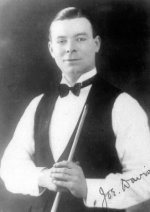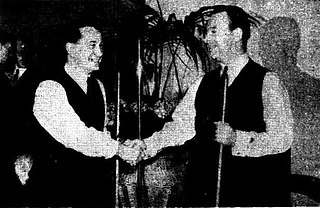
Joseph Davis was an English professional snooker and English billiards player. He was the dominant figure in snooker from the 1920s to the 1950s and has been credited with inventing aspects of the way the game is now played, such as break-building. With equipment manufacturer Bill Camkin, he drove the creation of the World Snooker Championship by persuading the Billiards Association and Control Council to recognise an official professional snooker championship in 1927. Davis won the first 15 championships from 1927 to 1946 and remains the only undefeated player in World Snooker Championship history. He scored the championship's first century break, in 1930.
The 1927 World Snooker Championship was a snooker tournament held at various venues from 29 November 1926 to 12 May 1927. At the time, it was called the Professional Championship of Snooker but it is now recognised as the inaugural edition of the World Snooker Championship. The impetus for the championship came from professional English billiards player Joe Davis and billiard hall manager Bill Camkin, who had both observed the growing popularity of snooker, and proposed the event to the Billiards Association and Control Council. There were ten players who entered the competition, including most of the leading billiards players. The two matches in the preliminary round were held at Thurston's Hall in London, and the semi-finals final took place at Camkin's Hall in Birmingham. Venues for the quarter-finals were determined by the players involved, resulting in one match being held at Thurston's Hall, one at Camkin's Hall, and one each in Nottingham and Liverpool.
The 1969 World Snooker Championship was a professional snooker tournament. It was the first World Snooker Championship in a knock-out format since 1957, following a series of challenge matches from 1964 to 1968. John Spencer won the title, defeating Gary Owen by achieving a winning margin at 37 frames to 24 in the final. Spencer had earlier eliminated defending champion John Pulman from the competition, in the quarter-finals.
The 1929 World Snooker Championship, known at the time as the Professional Championship of Snooker, was a snooker tournament held between 17 December 1928 and 7 March 1929 at various venues in England, with the final taking place from 4 to 7 March 1929 at the Lounge Hall, Nottingham. Defending champion Joe Davis won the title for the third time by defeating Tom Dennis by 19 frames to 14 in the final, after securing a winning margin at 17–12.
The 1930 World Snooker Championship, known at the time as the Professional Championship of Snooker, was a snooker tournament held between 17 March and 23 May 1930 at various venues in England, with the final taking place from 19 to 24 May at Thurston's Hall, London. Defending champion Joe Davis won the title for the fourth time by defeating Tom Dennis by 25 frames to 12 in the final.
The 1931 World Snooker Championship was a snooker tournament held at the Lounge Hall in Nottingham, England from 27 April to 1 May 1931. Despite increasing interest in the game of snooker, only two players entered the competition for the title: defending champion Joe Davis and three-times runner-up Tom Dennis. It was the fifth time that the World Snooker Championship had been contested since its inception in 1927. Davis won his fifth World title by defeating Dennis 25–21. Dennis led 19–16 at one stage but Davis won 9 of the next 11 frames to take the title. The highest break of the match was 72, compiled by Davis in the 41st frame.
The 1932 World Snooker Championship, known at the time as the Professional Championship of Snooker, was a professional snooker tournament that took place from 14 to 20 April 1932, with the final being held at Thurston's Hall in London, England. It is recognised as the sixth edition of the World Snooker Championship. The defending champion, Joe Davis from England, won the title for the sixth time by defeating New Zealander Clark McConachy by 30 frames to 19 in the final. The score when Davis achieved a winning margin was 25–18, with dead frames played afterwards. Davis set a new Championship record break of 99 in the 36th frame of the final. McConachy had become the first player from outside the British Isles to enter the championship. The only other participant was Tom Dennis, who was defeated 11–13 by McConachy in the semi-final at Skegness.
The 1933 World Snooker Championship, known at the time as the Professional Championship of Snooker, was a snooker tournament held between 23 March and 16 June at various venues in England, with the final beginning on 12 June 1933 at Joe Davis's Saloon in Chesterfield, England. It was the seventh edition of the championship, and Joe Davis won his seventh title by defeating Willie Smith by 25 frames to 18 in the final. The highest break of the tournament was 72, compiled by Davis in the fortieth frame of the final.
The 1934 World Snooker Championship, known at the time as the Professional Championship of Snooker, was a snooker tournament held partly at the Lounge Hall in Nottingham and then at the Central Hall in Kettering, from 2 to 6 April 1934. Joe Davis won the title for the eighth time by defeating Tom Newman, the only other entrant, by 25 frames to 22. At one stage Newman led 14–13, but Davis then pulled ahead to lead 24–18 and, although Newman won the next four frames, Davis took the 47th frame to secure the title. Davis compiled a break of 70 in the third frame.
The 1935 World Snooker Championship was a snooker tournament held at Thurston's Hall in London, England from 8 to 27 April 1935. It was the first edition of the Championship to incorporate "world" in its name, being called the World's Professional Snooker Championship. Joe Davis won the title for the ninth time by defeating Willie Smith by 28 frames to 21 in the final, having achieved a winning margin at 25–20. Davis recorded the first century break in the history of the championship, a 110 in his semi-final match against Tom Newman.
The 1936 World Snooker Championship was a snooker tournament that was held at the Burroughes and Thurston's Halls in London, England from 23 March to 2 May 1936. There were 13 entries; a significant increase from five in the previous year and just two in 1934. Defending champion Joe Davis won the Championship for the tenth consecutive time, defeating Horace Lindrum in the final 34–27. Horace Lindrum became the first Australian to compete at the World Championship and made the only century break of the tournament, a 101 in his semi-final match against Stanley Newman.
The 1937 World Snooker Championship was a snooker tournament held at Thurston's Hall in London, England from 22 February to 20 March 1937. It is recognised as the 11th edition of the World Snooker Championship. There were nine participants in the event, with debutants Fred Davis and Bill Withers competing in a qualifying match. Withers won the match to join with the remaining seven players in the main event.
The 1938 World Snooker Championship was a snooker tournament held from 14 March to 9 April 1938 at Thurston's Hall in London, England. It was the twelfth edition of the World Snooker Championship. Joe Davis won his twelfth championship title by defeating Sidney Smith by 37 frames to 24 in the final, after securing a winning margin at 31–23. The highest break of the tournament was 104, compiled by Davis in the sixth frame of his semi-final match against Willie Smith. It was the only century break during the event.
The 1939 World Snooker Championship was a snooker tournament held at Thurston's Hall in London, England from 23 January to 4 March 1939. It was the thirteenth edition of the World Snooker Championship. Joe Davis retained the championship title that he had held since 1927. In the best-of-73-frames final against Sidney Smith, Davis won the match 43–30, securing the victory at 37-25 earlier in the match. Fred Davis set a new championship highest break by compiling a 113 in the 22nd frame of his 14–17 semi-final defeat by his brother Joe Davis.
The 1940 World Snooker Championship was a professional snooker tournament held at Thurston's Hall in London, England from 22 February to 20 March 1940. It was the fourteenth edition of the World Snooker Championship. Joe Davis defeated his younger brother Fred Davis by 37 frames to 36 in the final, to retain the title that he had held since the tournament's inception in 1927. Joe Davis compiled a century break in the penultimate frame to win the match at 37–35 before a dead frame was played out. The only other century break of the tournament was 101 by Fred Davis earlier in the final.

The 1946 World Snooker Championship was a professional snooker tournament held from 4 February to 18 May 1946. Joe Davis won the title by defeating Horace Lindrum by 78 frames to 67 in the final, although the winning margin was reached at 73–62. It was Davis's fifteenth championship win, maintaining his unbeaten record in the tournament since its first edition in 1927. The highest break of the event was 136, a new championship record, compiled by Davis in the final.
The 1952 World Professional Match-play Championship was a snooker tournament held from 12 November 1951 to 15 March 1952, with the final taking place at the Tower Circus in Blackpool, England. The event was created following a dispute between the Professional Billiard Players' Association (PBPA) and the Billiards Association and Control Council (BACC). The BACC claimed that the championship was primarily about honour, and financial consideration should come behind this, whilst the PBPA members felt that the BACC was taking too large a share of the income from the events and established an alternative 'world championship' called the World Professional Match-play Championship, editions of which are now recognised as world championships.
The 1956 World Professional Match-play Championship was a snooker tournament that took place from 9 January to 10 March 1956 with the final being held at the Tower Circus in Blackpool, England from 5 to 10 March. Fred Davis won his eighth and last world snooker title by defeating John Pulman by 38 frames to 35 in the final. Pulman led 31–29 going into the last day of the final on 10 March, but Davis won 8 of the first 10 frames on that day to take a winning lead of 37–33. The event, organised by the Professional Billiards Players' Association, is now recognised as an edition of the World Snooker Championship.
The 1957 World Professional Match-play Championship was a professional snooker tournament held from 1 to 13 April in Saint Helier, Jersey. This was the 1957 edition of the World Snooker Championship first held in 1927. John Pulman won the event for the first time by defeating Jackie Rea 39–34 in the 73–frame final. Rea led in the early stages but Pulman pulled ahead and took a winning lead of 37–29 after the final afternoon session.
Fred Lawrence 18 June 1887 – 4 January 1964 was an English Billiards and snooker player. In 1919 he won a second-class professional billiards tournament at Thurston's Hall. He won the Midland Counties Billiards Championship in 1920, and 1921. Lawrence lost 13 - 16 to Joe Davis in the final of the 1928 World Snooker Championship.

